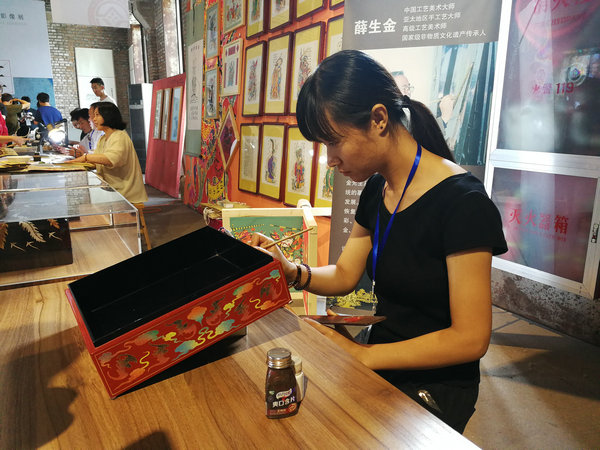 |
|
A woman demonstrates Pingyao's polished lacquer making during the recent photo and video exhibition about intangible cultural heritage in Pingyao, Shanxi province. [Photo by Liu Xiangrui/China Daily] |
"However, the experts said that after watching my documentary, the epic songs will never be lost, because people will be able to learn them whenever they want (by watching the film)."
The Hani people only developed their own written language over the past few decades. Before then, the details of their ethnic history and culture were passed on through oral accounts and epic songs, Fu says.
Fu documented an entire song, which lasted several hours, and made a transcript of the content with the help of professional language experts.
During the three-day event in Pingyao, nearly a hundred scholars from the film and television arts, anthropology, ethnology, folk culture, as well as representatives from the documentary and film industry attended forums discussing innovative ways to protect intangible cultural heritage.
Documentary makers have been playing an increasingly important role in protecting and popularizing China's intangible cultural heritage, and it has additional advantages in some aspects compared to language and the written word, says Lei Jianjun, a professor from the department of journalism and communication at Tsinghua University, during the event.
He cited the example of Masters in the Forbidden City, a documentary recording the daily work of cultural relic repairers at the Palace Museum in Beijing, which was first broadcast on China Central Television in 2016.
The documentary enjoyed extremely broad popularity, and the department in charge of the protection of cultural relics at the museum quickly became a household name in China.
Thanks to this, and after the department changed its name to Hospital for Cultural Relics, more than 20,000 people applied for positions at the branch, which was previously unpopular.
"To bring action through propagation, that's the true value of documentaries," Lei says.
The film producers attending the exhibition were also invited to exchange ideas with the audience after their works were screened in Pingyao.
To enrich the exhibition and promote intangible cultural heritage, the organizing committee also invited inheritors of eight different types of intangible cultural heritage from Pingyao, including polished lacquer craftsmen and traditional clothing makers, to perform their techniques on site.
Geng Baoguo, a 70-year-old inheritor of Pingyao's polished lacquer making, a national intangible cultural heritage, believes modern technology can help better preserve and promote his craft.
"Fewer young people are willing to take up the craft. It's good to let people know more about what we do through these documentaries," says Geng.
Contact the writer at liuxiangrui@chinadaily.com.cn